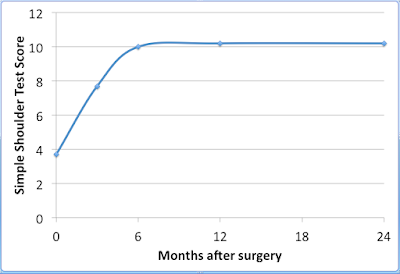These authors conducted a systematic review identifying 13 studies (984 patients) reporting sequential followup at several time points, up to a minimum of 2 years, after TSA for osteoarthritis.
Clinically significant improvements in patient-reported outcome scores were realized up to 1 year following TSA, but no further clinical significance was seen from 1 year to 2 years.
For both subjective and objective outcomes, the majority of improvements occurred in the first 3 months after the procedure. This is well demonstrated by the Simple Shoulder Test (SST) score.
The results were not different for the other scoring instruments, most of which are more complex and take longer to complete than the SST .
Comment: Traditionally, journals require a "minimum of two year followup" for articles on arthroplasty of the shoulder and other joints. This article reveals that on average the clinical outcome is evident at 12 months after surgery. On the other hand, a realistic picture of the rates of glenoid component loosening (the most common complication of total shoulder arthroplasty) or surgical revision requires followup in excess of five years. One included study reported an average time to revision surgery of 8.8 years. Another pointed out that only 30% of the revisions took place in the first two years after surgery.
We conclude that most patients achieve maximal clinical improvement within a year after total shoulder arthroplasty. Understanding the longer term clinical outcomes that are of great interest to surgeons and patients alike requires a concerted effort to collect annual patient self-assessments over a decade or longer. This objective is facilitated by using a questionnaire such as the Simple Shoulder Test that is easy to complete, easy to score, and less likely to suffer from "question exhaustion". Instruments that require measurements by a provider, such as the Constant score, are not well suited to this type of longitudinal followup.
=====
Use the "Search" box to the right to find other topics of interest to you.
Use the "Search" box to the right to find other topics of interest to you.
You may be interested in some of our most visited web pages including:shoulder arthritis, total shoulder, ream and run, reverse total shoulder, CTA arthroplasty, and rotator cuff surgery as well as the 'ream and run essentials'


